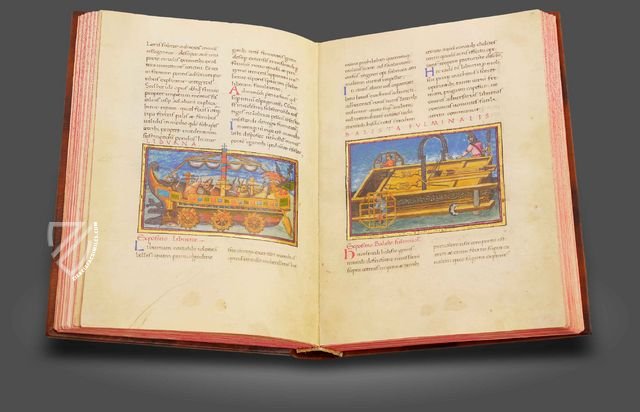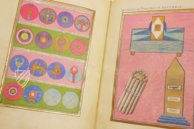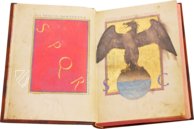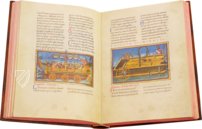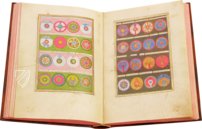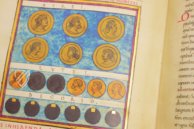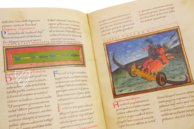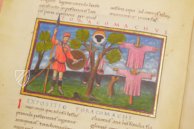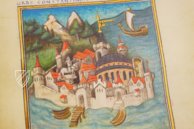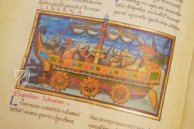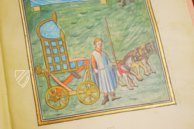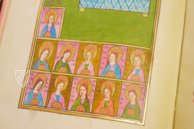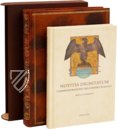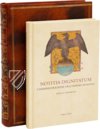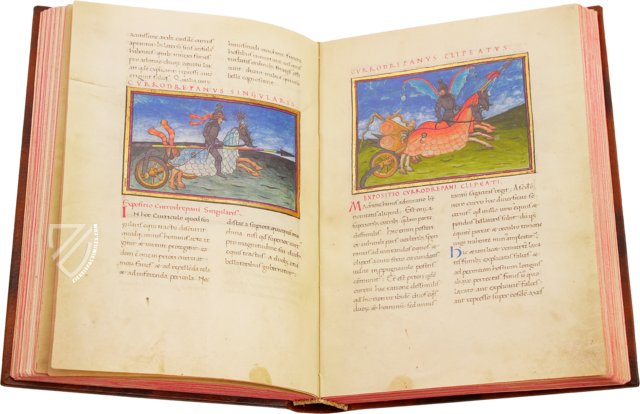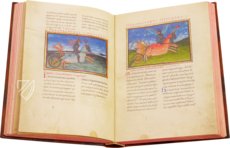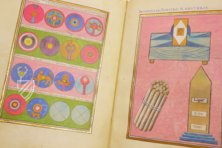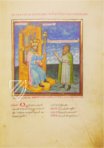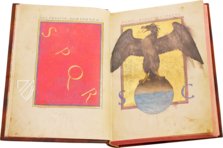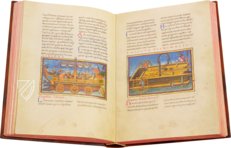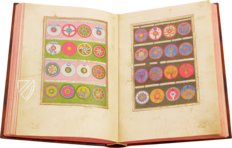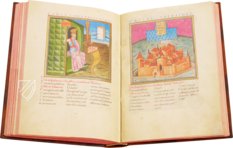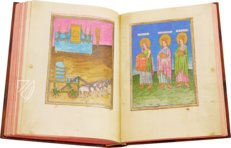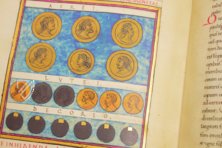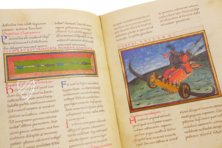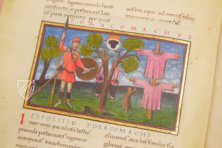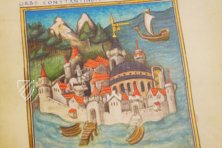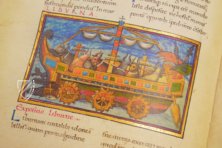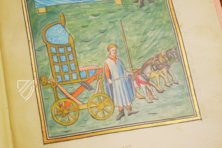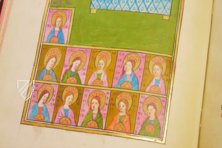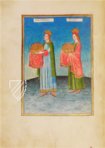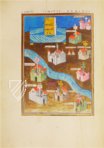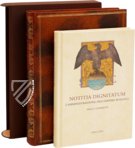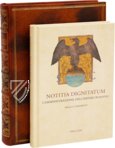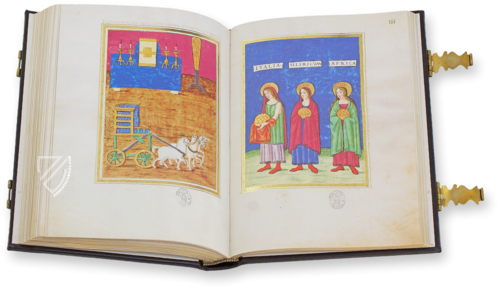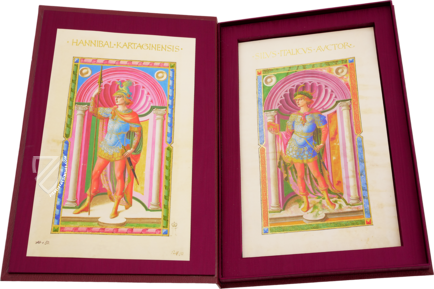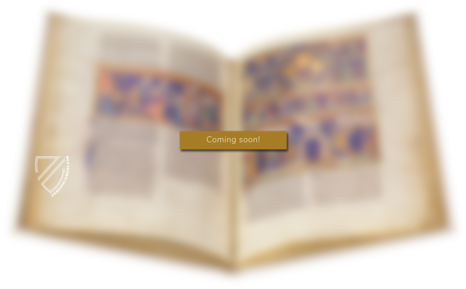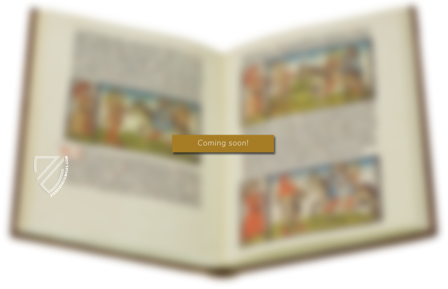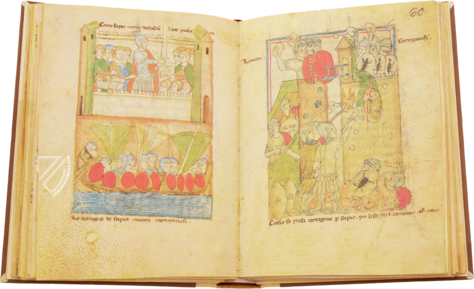Oxford Notitia Dignitatum
(3,000€ - 7,000€)
A unique historical treasure is known today under the title Notitia Dignitatum: a Roman state registry from the 5th century containing extremely exciting information about the military and civil organization of the Late Roman Empire. The original is lost today but has been recorded in four medieval transcripts, the oldest and most important of which is stored in Oxford’s Bodleian Library and grants a wonderful inside view into the Roman Empire of late antiquity. The work was commissioned by Pietro Donato and Savoy miniaturist Perronet Lamy served as the illuminator of the manuscript, which he created in 1436. Working in Basel, Switzerland, he furnished it with 109 gorgeous miniatures based on classical examples including detailed depictions of the armaments, clothing, and armor of the army at the end of the 4th century as well as illustrations of stylized cityscapes, tables with shield patterns of the various military units, insignias, and images of ancient coins.
Oxford Notitia Dignitatum
Manuscript Canon. Misc. 378 of Oxford’s Bodleian Library counts among the most precious pieces of evidence of the Late Roman Empire. The historic specimen was made in the year 1436 for Pietro Donato, the Bishop of Padua (1428.1447), who inter alia chaired the Council of Basel in 1436. This manuscript was copied from a now-lost 9th century Carolingian manuscript from the Speyer Cathedral treasury and is considered to be the oldest surviving manuscript of the Notitia Dignitatum.
Grandiose Medieval Illumination for a Roman State Registry
Pietro Donato presumably contracted the Savoy miniaturist Perronet Lamy as the illuminator of the manuscript. In the last quarter of the 15th century, Perronet Lamy was active for the House of Savoy above all, but also stood in the service of the Bishop of Padua on occasion. It was for him that the transcript at hand of the Notitia Dignitatum, a true gem of illumination and history, was created! In doing so, Perronet Lamy partially copied the example, but also appended it through his own visual inventions and presented all his ability in the wonderful and detailed depictions of the armaments, clothing, and armor of the warriors or a figurative depiction of an enthroned Hadrian in conversation with the philosopher Epictetus standing before him.
How Did the Roman Empire Function
The manuscript of the Notitia Dignitatum presents itself both as an important source for knowledge about the administrative organization of the Late Roman Empire as well as for the rediscovery of Greek antiquity during the Renaissance period. In the notitia dignitatum omnium tam civilium quam militarium, the administrative and military organization of both the Western and Eastern Roman Empires recorded. For example, one finds a register of all civil and military dignities, offices, and troops organized according to the ranks of the hierarchy. The script is gorgeously illustrated with illustrations of stylized cityscapes, tables with shield patterns of the various military units, insignias, and images of ancient coins.
Codicology
- Alternative Titles
- List of Offices
Il codice Notitia Dignitatum
Notitia Dignitatum et Administrationum Omnium tam Civilium quam Militarium
Notitia Dignitatum by Peronet Lamy
Notitia Dignitatum von Peronet Lamy - Size / Format
- 348 pages / 27.5 × 19.7 cm
- Origin
- Italy
- Date
- 1436
- Epochs
- Style
- Language
- Script
- Humanistic minuscule
- Illustrations
- 109 miniatures
- Content
- Presentation of the administrative and military structures of the Roman Empire in Late Antiquity
- Patron
- Pietro Donato (1380–1447), Bishop of Padua
- Artist / School
- Peronet Lamy
Oxford Notitia Dignitatum
The Debate of Emperor Hadrian and Epictetus
A fictitious dialogue between the Roman Emperor Hadrian and the Greek Stoic philosopher Epictetus was written during the 2nd or 3rd century, which continued to be popular during the Middle Ages. Nonetheless, Hadrian was supposedly friendly with Epictetus and may have heard him speak at his school in Nicopolis. As one of the “Five Good Emperors”, Hadrian was praised by medieval authors for his learnedness and even the staunchly republican Machiavelli described him as an ideal princeps.
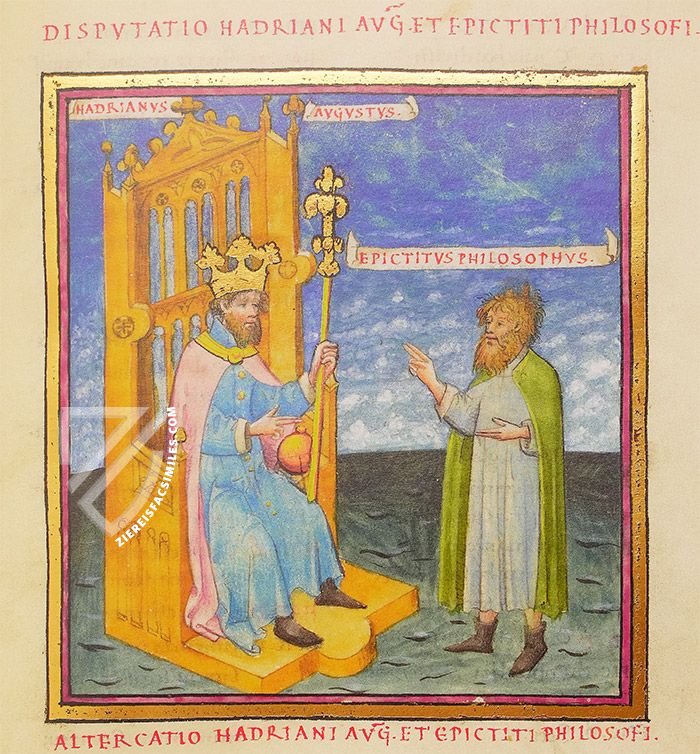
Oxford Notitia Dignitatum
Magister Officiorum West
The production of arms, armor, and other equipment was centralized in the 4th century and here we see the helmets, shields, mail coats, cuirasses, laminated greaves, swords, spears, axes, hammers, and other tools that were produced by the fabricae or “arms factories” for the Late Roman Army.
The caption at the top of the page also informs us that these shields have the insignia of the Western units of the Scholae Palatinae, an elite military guard created by Emperor Constantine the Great as a replacement for the Praetorian Guard, which continued to function in the Eastern Roman / Byzantine Empire until the 11th century. They were largely recruited from the Franks and Alemanni, but native Romans also served, especially as officers.
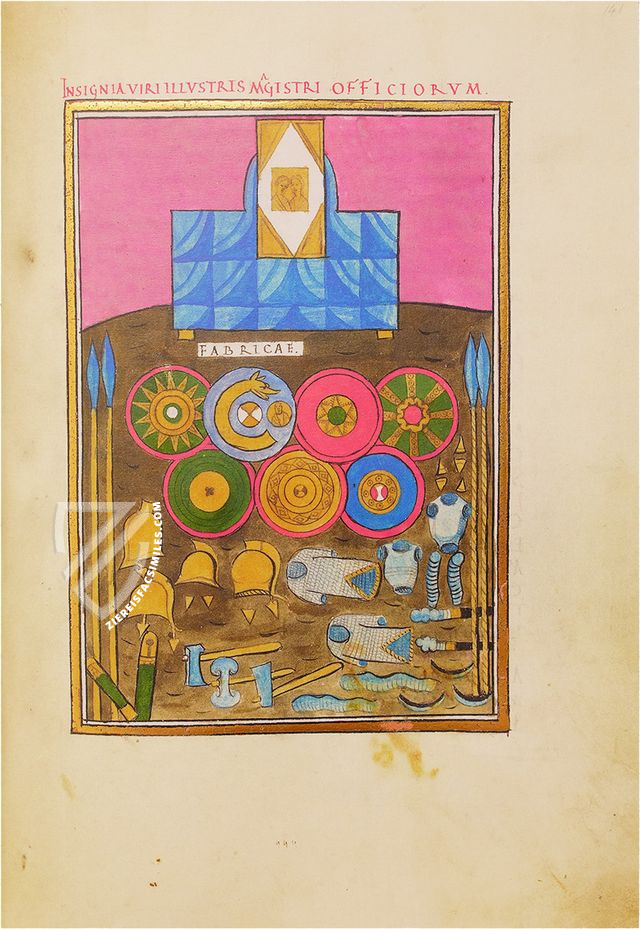
#1 Notitia Dignitatum
Languages: Italian
(3,000€ - 7,000€)
- Treatises / Secular Books
- Apocalypses / Beatus
- Astronomy / Astrology
- Bestiaries
- Bibles / Gospels
- Chronicles / History / Law
- Geography / Maps
- Saints' Lives
- Islam / Oriental
- Judaism / Hebrew
- Single Leaf Collections
- Leonardo da Vinci
- Literature / Poetry
- Liturgical Manuscripts
- Medicine / Botany / Alchemy
- Music
- Mythology / Prophecies
- Psalters
- Other Religious Books
- Games / Hunting
- Private Devotion Books
- Other Genres
- Afghanistan
- Armenia
- Austria
- Belgium
- Belize
- Bosnia and Herzegovina
- China
- Colombia
- Costa Rica
- Croatia
- Cyprus
- Czech Republic
- Denmark
- Egypt
- El Salvador
- Ethiopia
- France
- Germany
- Greece
- Guatemala
- Honduras
- Hungary
- India
- Iran
- Iraq
- Israel
- Italy
- Japan
- Jordan
- Kazakhstan
- Kyrgyzstan
- Lebanon
- Liechtenstein
- Luxembourg
- Mexico
- Morocco
- Netherlands
- Palestine
- Panama
- Peru
- Poland
- Portugal
- Romania
- Russia
- Serbia
- Spain
- Sri Lanka
- Sweden
- Switzerland
- Syria
- Tajikistan
- Turkey
- Turkmenistan
- Ukraine
- United Kingdom
- United States
- Uzbekistan
- Vatican City
- A. Oosthoek, van Holkema & Warendorf
- Aboca Museum
- Ajuntament de Valencia
- Akademie Verlag
- Akademische Druck- u. Verlagsanstalt (ADEVA)
- Aldo Ausilio Editore - Bottega d’Erasmo
- Alecto Historical Editions
- Alkuin Verlag
- Almqvist & Wiksell
- Amilcare Pizzi
- Andreas & Andreas Verlagsbuchhandlung
- Archa 90
- Archiv Verlag
- Archivi Edizioni
- Arnold Verlag
- ARS
- Ars Magna
- ArtCodex
- AyN Ediciones
- Azimuth Editions
- Badenia Verlag
- Bärenreiter-Verlag
- Belser Verlag
- Belser Verlag / WK Wertkontor
- Benziger Verlag
- Bernardinum Wydawnictwo
- BiblioGemma
- Biblioteca Apostolica Vaticana (Vaticanstadt, Vaticanstadt)
- Bibliotheca Palatina Faksimile Verlag
- Bibliotheca Rara
- Boydell & Brewer
- Bramante Edizioni
- Bredius Genootschap
- Brepols Publishers
- British Library
- C. Weckesser
- Caixa Catalunya
- Canesi
- CAPSA, Ars Scriptoria
- Caratzas Brothers, Publishers
- Carus Verlag
- Casamassima Libri
- Centrum Cartographie Verlag GmbH
- Chavane Verlag
- Christian Brandstätter Verlag
- Circulo Cientifico
- Club Bibliófilo Versol
- Club du Livre
- CM Editores
- Collegium Graphicum
- Collezione Apocrifa Da Vinci
- Comissão Nacional para as Comemorações dos Descobrimentos Portugueses
- Coron Verlag
- Corvina
- CTHS
- D. S. Brewer
- Damon
- De Agostini/UTET
- De Nederlandsche Boekhandel
- De Schutter
- Deuschle & Stemmle
- Deutscher Verlag für Kunstwissenschaft
- DIAMM
- Droz
- E. Schreiber Graphische Kunstanstalten
- Ediciones Boreal
- Ediciones Grial
- Ediclube
- Edições Inapa
- Edilan
- Editalia
- Edition Deuschle
- Edition Georg Popp
- Edition Leipzig
- Edition Libri Illustri
- Editiones Reales Sitios S. L.
- Éditions de l'Oiseau Lyre
- Editions Medicina Rara
- Editorial Casariego
- Editorial Mintzoa
- Editrice Antenore
- Editrice Velar
- Edizioni Edison
- Egeria, S.L.
- Eikon Editores
- Electa
- Emery Walker Limited
- Enciclopèdia Catalana
- Eos-Verlag
- Ephesus Publishing
- Ernst Battenberg
- Eugrammia Press
- Extraordinary Editions
- Fackelverlag
- Facsimila Art & Edition
- Facsimile Editions Ltd.
- Facsimilia Art & Edition Ebert KG
- Faksimile Verlag
- Feuermann Verlag
- Folger Shakespeare Library
- Franco Cosimo Panini Editore
- Friedrich Wittig Verlag
- Fundación Hullera Vasco-Leonesa
- G. Braziller
- Gabriele Mazzotta Editore
- Gebr. Mann Verlag
- Gesellschaft für graphische Industrie
- Getty Research Institute
- Giovanni Domenico de Rossi
- Giunti Editore
- Graffiti
- Grafica European Center of Fine Arts
- Guido Pressler
- Guillermo Blazquez
- Gustav Kiepenheuer
- H. N. Abrams
- Harrassowitz
- Harvard University Press
- Helikon
- Hendrickson Publishers
- Henning Oppermann
- Herder Verlag
- Hes & De Graaf Publishers
- Hoepli
- Holbein-Verlag
- Houghton Library
- Hugo Schmidt Verlag
- Idion Verlag
- Il Bulino, edizioni d'arte
- ILte
- Imago
- Insel Verlag
- Insel-Verlag Anton Kippenberger
- Instituto de Estudios Altoaragoneses
- Instituto Nacional de Antropología e Historia
- Introligatornia Budnik Jerzy
- Istituto dell'Enciclopedia Italiana - Treccani
- Istituto Ellenico di Studi Bizantini e Postbizantini
- Istituto Geografico De Agostini
- Istituto Poligrafico e Zecca dello Stato
- Italarte Art Establishments
- Jan Thorbecke Verlag
- Johnson Reprint Corporation
- Josef Stocker
- Josef Stocker-Schmid
- Jugoslavija
- Karl W. Hiersemann
- Kasper Straube
- Kaydeda Ediciones
- Kindler Verlag / Coron Verlag
- Kodansha International Ltd.
- Konrad Kölbl Verlag
- Kurt Wolff Verlag
- La Liberia dello Stato
- La Linea Editrice
- La Meta Editore
- Lambert Schneider
- Landeskreditbank Baden-Württemberg
- Leo S. Olschki
- Les Incunables
- Liber Artis
- Library of Congress
- Libreria Musicale Italiana
- Lichtdruck
- Lito Immagine Editore
- Lumen Artis
- Lund Humphries
- M. Moleiro Editor
- Maison des Sciences de l'homme et de la société de Poitiers
- Manuscriptum
- Martinus Nijhoff
- Maruzen-Yushodo Co. Ltd.
- MASA
- Massada Publishers
- McGraw-Hill
- Metropolitan Museum of Art
- Militos
- Millennium Liber
- Müller & Schindler
- Nahar - Stavit
- Nahar and Steimatzky
- National Library of Wales
- Neri Pozza
- Nova Charta
- Oceanum Verlag
- Odeon
- Orbis Mediaevalis
- Orbis Pictus
- Österreichische Staatsdruckerei
- Oxford University Press
- Pageant Books
- Parzellers Buchverlag
- Patrimonio Ediciones
- Pattloch Verlag
- PIAF
- Pieper Verlag
- Plon-Nourrit et cie
- Poligrafiche Bolis
- Presses Universitaires de Strasbourg
- Prestel Verlag
- Princeton University Press
- Prisma Verlag
- Priuli & Verlucca, editori
- Pro Sport Verlag
- Propyläen Verlag
- Pytheas Books
- Quaternio Verlag Luzern
- Reales Sitios
- Recht-Verlag
- Reichert Verlag
- Reichsdruckerei
- Reprint Verlag
- Riehn & Reusch
- Roberto Vattori Editore
- Rosenkilde and Bagger
- Roxburghe Club
- Salerno Editrice
- Saltellus Press
- Sandoz
- Sarajevo Svjetlost
- Schöck ArtPrint Kft.
- Schulsinger Brothers
- Scolar Press
- Scrinium
- Scripta Maneant
- Scriptorium
- Shazar
- Siloé, arte y bibliofilia
- SISMEL - Edizioni del Galluzzo
- Sociedad Mexicana de Antropología
- Société des Bibliophiles & Iconophiles de Belgique
- Soncin Publishing
- Sorli Ediciones
- Stainer and Bell
- Studer
- Styria Verlag
- Sumptibus Pragopress
- Szegedi Tudomànyegyetem
- Taberna Libraria
- Tarshish Books
- Taschen
- Tempus Libri
- Testimonio Compañía Editorial
- Thames and Hudson
- The Clear Vue Publishing Partnership Limited
- The Facsimile Codex
- The Folio Society
- The Marquess of Normanby
- The Richard III and Yorkist History Trust
- Tip.Le.Co
- TouchArt
- TREC Publishing House
- TRI Publishing Co.
- Trident Editore
- Tuliba Collection
- Typis Regiae Officinae Polygraphicae
- Union Verlag Berlin
- Universidad de Granada
- University of California Press
- University of Chicago Press
- Urs Graf
- Vallecchi
- Van Wijnen
- VCH, Acta Humaniora
- VDI Verlag
- VEB Deutscher Verlag für Musik
- Verlag Anton Pustet / Andreas Verlag
- Verlag Bibliophile Drucke Josef Stocker
- Verlag der Münchner Drucke
- Verlag für Regionalgeschichte
- Verlag Styria
- Vicent Garcia Editores
- W. Turnowski Ltd.
- W. Turnowsky
- Waanders Printers
- Wiener Mechitharisten-Congregation (Wien, Österreich)
- Wissenschaftliche Buchgesellschaft
- Wissenschaftliche Verlagsgesellschaft
- Wydawnictwo Dolnoslaskie
- Xuntanza Editorial
- Zakład Narodowy
- Zollikofer AG

